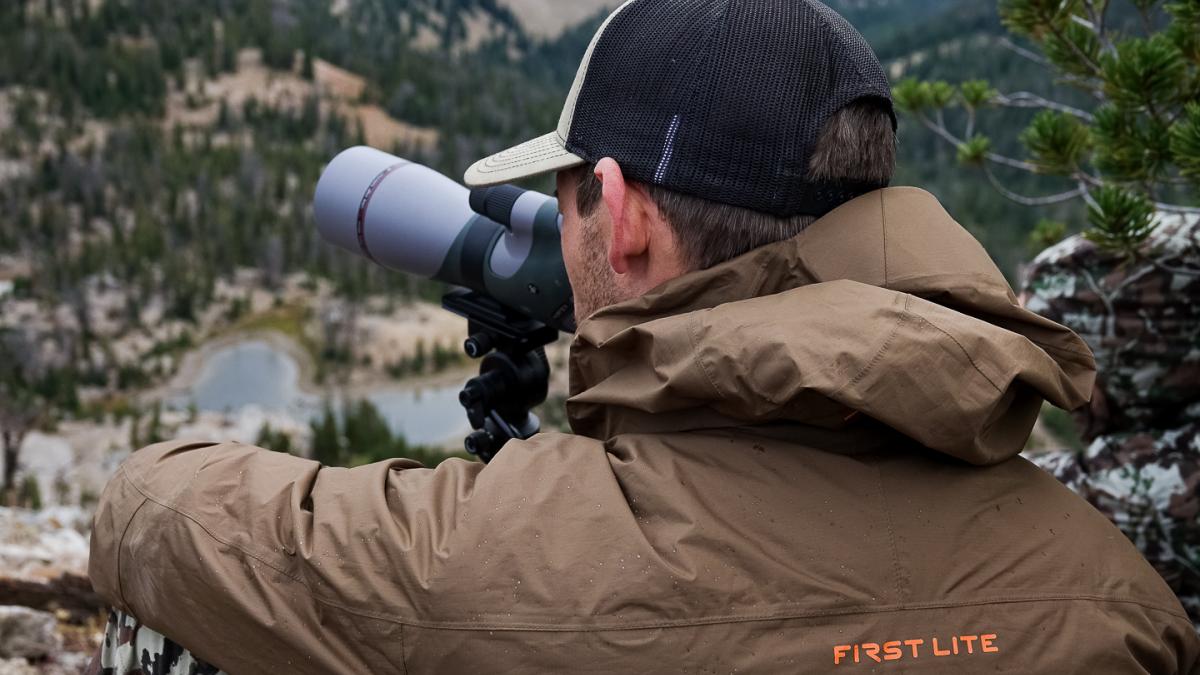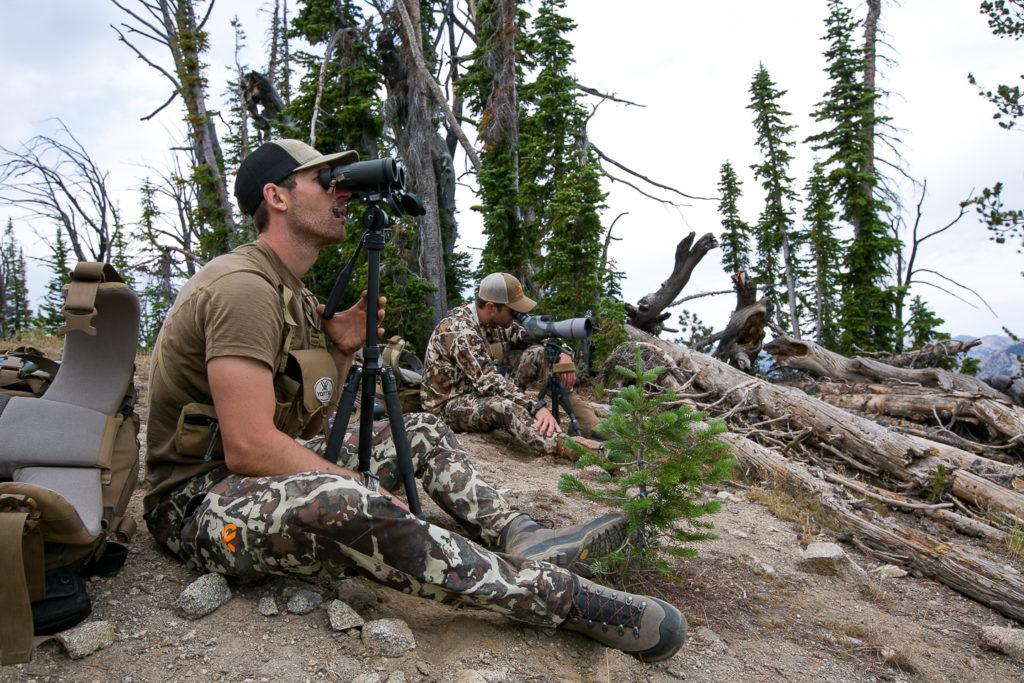
A Backcountry Hunters Layering Guide–Part 1-The Basics
By Brad Brooks
I have seen my fair share of guys in wranglers and cotton flannels packing out big bulls. But I've seen way more people fleeing the mountains after a sustained rain or snow storm due to improper clothing layering and the misery that follows. Clothing is important when hunting, and no matter what brand or camo pattern you decide to use (or not to use), understanding proper layering will allow you to hunt in any condition mother nature can throw at you.
At its core, layering is about efficiency, comfort and body temperature regulation. Those are all code words for keeping you comfortable, particularly when hunting in remote places. Even more importantly, layering helps keep you from getting too hot or too cold, which keeps your brain functioning properly and your attitude in the right place so you keep hunting longer instead of bailing back to the truck because you're miserable. And when done well, layering reduces the weight and bulk of your pack.

This layering piece is meant for hunters that take efficiency, weight and clothing seriously. If done properly, you should be wearing all your clothes when temperatures are lowest. Not *most* of your clothes. All of them. But figuring out the minimum amount of clothing to take, particularly on a backcountry or backpack hunt when weight and space are at a premium can be complicated. If you don't pack properly, you end up having an extra piece of clothing that does nothing but add weight and take up space in your bag.
Rather than just jump to telling you what pieces of clothing work best, you'll be better off in the long run by understanding why layering matters, and how to do it properly. This guide explains the fundamentals of proper layering and also covers the relative merits of down vs. synthetic insulation.
Layering Basics
Layering is typically comprised of baselayers, midlayers and insulating or outerlayers. Simple enough, but the reason multiple layers is advantageous over a couple heavy insulating layers has to do with temperature regulation under a greater variety of conditions.
To exaggerated the point, if you took a long sleeve shirt and a Mount-Everest sized full down suit on a hunting trip as your only clothes you will likely be too hot or too cold. If you have 5-6 layers, you can add or subtract pieces to as needed to find the ideal amount of clothing to wear in the morning, when it warms up in the day and at night.

Air and Moisture
Still air is one of the best insulators out there. Still air does not transfer heat very well (it traps heat), so the more still air you can trap between your body and the elements, the more body heat you will retain. We could get into a physics lesson on how heat is transferred, but let's not do that.
Moisture against your body is the opposite of air when it comes to thermal regulation. Moving moisture away from the skin is critical to maintaining body temperature. Moisture trapped against your skin will keep you colder by drawing heat away from your body. Proper layering, and using a quality material like merino wool, will literally pull moisture away from your body. That wicking effect of clothing is important, and you have to have multiple layers of clothing that can "breath" or else that moisture will get trapped.
To conclude: moisture bad, air good when it comes to insulation, layering and thermal regulation.
Merino Wool vs. Polypro
For years I used standard polypro for all of my active outdoor pursuits, but when the merino wool started hitting the market I slowly made the switch, particularly for base layers. Merino wool is in nearly every way a superior material for hunters, and in particular backcountry or backpack hunters. The two most important factors for me are 1) Heat retention when wet, and 2) Natural scent protection. Merino will retain nearly 60% of its heat retention properties when wet, which is important when you are sweating heavily or the weather turns on you. Unlike cotton, merino wool can still trap air against your body when wet due to the intrinsic properties of the fabric. Merino will also keep you smelling semi-normal, even after a week-long trip, whereas a polyester layer will smell like a high school locker room within hours.
That said, I do use some polyester layers, just not for my first two next to skin layers most of the time. Polyester is warm, and it holds up to abuse better than most merino wool I've worn. Polyester also doesn't retain moisture the same way merino wool can, so it will dry out more quickly. There are even some polyester fabrics for baselayers that will actively wick moisture away from your body, making them avantageous in very warm weather hunting where you want to not wet-out your shirt and wick moisture away. It is a bit of a personal choice, but I still almost always choose merino wool, even in hot weather.
To summarize, merino wool is preferred for baselayers in my opinion, but polyester is still great, especially for midlayers, and in really hot weather, can help to keep you cooler than merino.
Down Vs. Synthetic insulation
Both goose down and synthetic insulation work well. I use both, and will continue to use both in the future. The problem with down is that if it gets really wet, it is useless. The upside is it seems to be slightly more efficient for the weight compared to a quality synthetic insulation. In reality, if you carry a rain jacket, you should be able to avoid having your down get drenched, but it is something you have to pay attention to. If you hunt in really wet weather, synthetic insulation is the way to go.
I've been using more synthetic insulating jackets over the past few years, and really liking them. There are some great synthetic insulation pieces out there that utilize active insulation that are efficient, light, layer well and have the added benefit of keeping me somewhat warm when wet. I tend to prefer synthetic insulation jackets as midlayer type jackets instead of for my warmest jackets as you can add a lot of goose down without a lot of weight, which can make for a vary warm lightweight jacket.
Bottom line: You can't go wrong with either, so find a jacket that fits you well and layers over your other clothing without making you look like a marshmallow so you can still draw your bow back when you need to.
Baselayers
A baselayer's primary job is to keep moisture away from your skin. A quality merino wool or polypro material will help remove moisture from you body and push it into the atmoshpere, making it easier for your body to regulate its temperature. A quality baselayer might not leave your body for a week long trip if you are backpacking, which is why I use merino wool since it has superior scent protection. Even in warm weather, a long sleeve shirt can have the counter-intuitive effect of keeping you cooler and protected from the sun.
Midlayers
These layers need to wick moister and be able to trap air. A good quality midlayer should fit snuggly over your baselayer(s), and ideally is heavy enough to serve as an outlerlayer during the early hunting season (August and early September) and as an insulating layer as the season progresses.
Outerlayers

Insulating jackets and rain jackets provide the finishing touch on your kit as outerlayers. Insulating jackets come in all shapes and sizes, so you'll have to play around to figure out what size or sizes you need without over-doing it and bringing in a 3 pound jacket. Down and synthetic jackets will cap off your upper body layering system, as can rain jackets.
Don't underestimate the value a rain jacket can play in insulation. While the jacket itself doesn't offer insulation, it keeps the wind from pulling warm, trapped air away from your body.